#NASA | ESA | CSA | STSCI
Explore tagged Tumblr posts
Text
Scientists Find Origin-of-Life Molecule in Space for First Time
— By Jess Thomson | August 8, 2023

NASA image of the Tarantula Nebula star-forming region taken by Webb’s Near-Infrared Camera. A molecular cloud in interstellar space has been found to contain carbonic acid for the first time. NASA, ESA, CSA, AND STSCI
molecule common to Earth and usually associated with life has been detected in the depths of space by scientists.
Carbonic acid (HOCOOH), which you may know as the chemical that makes your soda fizzy, was discovered lurking near the center of our galaxy in a galactic center molecular cloud named G+0.693-0.027, a study published in The Astrophysical Journal revealed.
This marks the third time that carboxylic acids—this class of chemicals, often thought to be some of the building blocks of life—have been detected in space, after acetic acid and formic, and the first time that an interstellar molecule has been found to contain three or more oxygen atoms.
"Our observations have allowed us to know that carbonic acid, which until now had remained invisible to our eyes, is relatively abundant in space, which makes it an essential piece to understand the interstellar chemistry of carbon and oxygen, two of the fundamental chemical elements in any prebiotic process," Víctor M. Rivilla, a researcher at the Spanish Center for Astrobiology and co-author of the study, told German broadcaster Deutsche Welle (DW).
"This result confirms that the path we have chosen is the right one to search for, and detect more molecules that we suspect were key to the appearance of life on our planet," he concluded.
Carboxylic acids are a type of organic compound characterized by a carbon (C) atom doubly bonded to an oxygen (O) atom and singly bonded to a hydroxyl group (―OH). Carbonic acid in particular is formed when CO2 is dissolved in water, meaning that it is present in increased concentrations in our seas due to CO2 in the atmosphere.
Many theories as to how life on Earth evolved suggest that primitive life may have emerged from a primordial soup of chemicals when our planet was very young. Some have suggested that these chemicals, including carboxylic acids, may have arrived on Earth from space, traveling via comets and meteorites to the forming planet.
Carbonic acid has been previously detected on other astronomical bodies, including the icy moons of Jupiter, in some meteorites and comets, and even on Mars and Mercury, but until now, has not been seen in interstellar space.
The authors explained that the discovery of these more complex molecules in the interstellar medium may reveal clues about the origins of our planet and the life upon it.
"The presence of prebiotic COMs within extraterrestrial material thus firmly suggests the existence of carboxylic acids of increasing complexity in the ISM (interstellar medium), including amino acid–related species. Within this context, considerable efforts have been devoted to hunting for other acids, such as propenoic or acrylic acid, propanoic acid, cyanoacetic acid, glycolic acid, hydantoic acid, and glycine, whose identification in the [interstellar medium] remains elusive."
#Tech & Science#Origion | Life Molecule#Space#NASA | ESA | CSA | STSCI#Tarantula Nebula#Corbonic Acid (HOCOOH)#Astrobiology#Víctor M. Rivilla#Deutsche Welle (DW)#CO2#Carboxylic Acid#Moon | Jupiter | Mars | Mercury#Earth#Prebiotic COMs#ISM (Interstellar Medium)#Acids: Acrylic | Propanoic | Cyanoacetic | Glycolic | Hydantoic | Glycine
0 notes
Photo
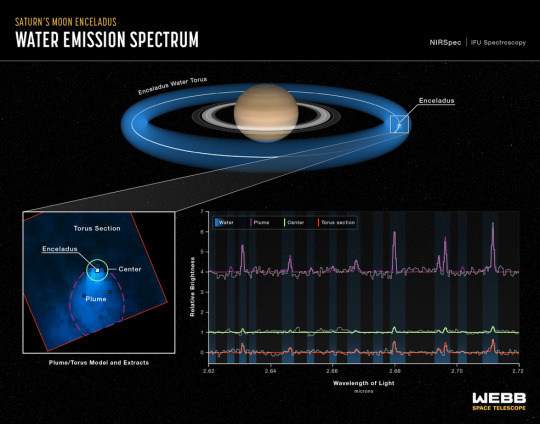


NASA'nın James Webb Uzay Teleskobu'nu kullanan araştırmacılar, Satürn'ün uydusu Enceladus'tan yaklaşık 6.000 milden (Los Angeles, California ile Buenos Aires, Arjantin arasındaki mesafe) yayılan bir su buharı bulutu tespit etti. Bu kadar geniş bir mesafede böyle bir su emisyonunun ilk kez görülmesinin yanı sıra Webb, bilim insanlarına ilk kez bu emisyonun tüm Satürn sistemi için su kaynağını nasıl beslediğine doğrudan bir bakış sunuyor. onun halkaları. Dünya'nın yaklaşık yüzde dördü büyüklüğünde, sadece 313 mil genişliğinde bir okyanus dünyası olan Enceladus, Dünya'nın ötesinde yaşam arayışında güneş sistemimizdeki en heyecan verici bilimsel hedeflerden biridir. Ay'ın buzlu dış kabuğu ile kayalık çekirdeği arasına sıkıştırılmış, küresel bir tuzlu su deposudur. Gayzer benzeri volkanlar, ayın yüzeyinde gayri resmi olarak 'kaplan çizgileri' olarak adlandırılan yarıklardan buz parçacıkları, su buharı ve organik kimyasallar püskürtür.
#NASA ESA CSA STScI Leah Hustak (STScI)#NASA ESA CSA STScI ve G. Villanueva (NASA'nın Goddard Uzay Uçuş Merkezi). Görüntü İşleme: A. Pagan (STScI).#teşekkürler
0 notes
Text

The distorted spiral galaxy at center, the Penguin, and the compact elliptical at left, the Egg, are locked in an active embrace. Known jointly as Arp 142, the galaxies made their first pass by one another between 25 and 75 million years ago, causing “fireworks,” or new star formation, in the Penguin. The galaxies are approximately the same mass, which is why one hasn’t consumed the other.
Image Credit: NASA, ESA, CSA, STScI
2K notes
·
View notes
Photo

2024 November 26
The Sombrero Galaxy from Webb and Hubble Image Credit: NASA, ESA, CSA, STScI, Hubble Heritage Project (STScI, AURA)
Explanation: This floating ring is the size of a galaxy. In fact, it is a galaxy -- or at least part of one: the photogenic Sombrero Galaxy is one of the largest galaxies in the nearby Virgo Cluster of Galaxies. The dark band of dust that obscures the mid-section of the Sombrero Galaxy in visible light (bottom panel) actually glows brightly in infrared light (top panel). The featured image shows the infrared glow in false blue, recorded recently by the space-based James Webb Space Telescope (JWST) and released yesterday, pictured above an archival image taken by NASA's Hubble Space Telescope in visible light. The Sombrero Galaxy, also known as M104, spans about 50,000 light years and lies 28 million light years away. M104 can be seen with a small telescope in the direction of the constellation Virgo.
∞ Source: apod.nasa.gov/apod/ap241126.html
173 notes
·
View notes
Photo

Ringed Ice Giant Neptune
Credits: NASA, ESA, CSA, STScI, NIRCam
67 notes
·
View notes
Text

It’s oh-so-easy to be mesmerized by this spiral galaxy known as NGC 4254. Follow its clearly defined arms, which are brimming with stars, to its center, where there may be old star clusters and, sometimes, active supermassive black holes. NASA’s James Webb Space Telescope delivered highly detailed scenes of this spiral galaxy in a combination of near- and mid-infrared light.
Image Credit & Copyright: NASA, ESA, CSA, STScI, Janice Lee (STScI), Thomas Williams (Oxford), and the PHANGS team
#astronomy#space#science#universe#galaxy#spiral galaxy#spiral#stars#hot stars#young stars#supermassive black hole#black hole#supermassive#James Webb#james webb space telescope#jwst#star clusters#star#cluster#star cluster#follow#like#reblog#the first star#the first starr#thefirststar#thefirststarr#nasa#apod#tumblr
196 notes
·
View notes
Text
Star-Birthing Shock Waves

Although the space between stars is empty by terrestrial standards, it's not devoid of matter. There's a scattering of cold gas and dust, pocked by areas known as prestellar cores with densities of a few thousand particles per cubic centimeter. (Image credit: NASA/ESA/CSA/STSCI/K. Pontoppidan/A. Pagan; see also Physics Today) Read the full article
#astronomy#astrophysics#flow visualization#fluid dynamics#physics#science#shock wave#stellar evolution
89 notes
·
View notes
Text

Stunning new image of our galactic center from JWST! This is a star forming region 300 lyr from the supermassive black hole in the center of the Milky Way. Cyan represents emission from ionized hydrogen, and it’s got some unexpected features 👀
📸: NASA, ESA, CSA, STScI, S Crowe
#astrography#astronomers#astrophysics#astrophotography#astrology#astronomy#astro observations#astro notes#space station#space science#space exploration#outer space#space#hubble space telescope#james webb space technology#jwst images#jwst#nasa picture of the day#nasa photos#nasa#nasawebb#orion nebula#nebula#james webb space telescope#space photography#our universe#universe#spaceporn#galaxies#galaxy
393 notes
·
View notes
Text
Cassiopeia A, the remnant of a star that exploded about 350 years ago. Calcium is one of many elements made in large stars and their explosions. How much? Enough for more than 10 million trillion trillion glasses of milk! 😳
📷: NASA, ESA, CSA, STScI
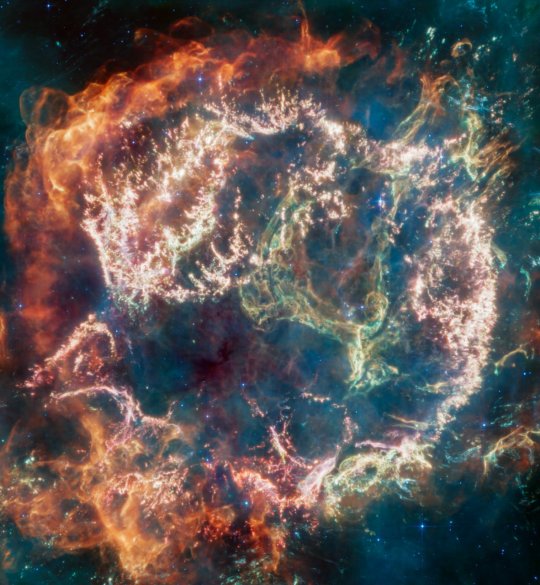
#astronomy#astrophysics#nasa#nebula#solar system#astrophotography#physics#james webb update#james webb space technology#james webb space telescope#james webb images#james webb telescope#james webb photos#nasa webb telescope#milk#calcium#supernova
406 notes
·
View notes
Text
The Year’s Most Spectacular Photos from the James Webb Telescope
By Jeffrey Kluger
December 22, 2023

Close to 1,500 light years from Earth lie a pair of baby stellar twins known as Herbig-Haro 46/47 — which are barely a few thousand years old.
A star the size of our sun, by contrast, takes an average of 50 million years to reach even the stellar equivalent of young adulthood It's Herbig-Haro 46/47's extreme youth that gives the formation more of a blob-like appearance than the stellar duo it is.
Young stars are buried in clouds of dust and gas, which they absorb as they grow. Sometimes, however the infant stars ingest too much material too fast.
When that happens, dust and gas erupts from both sides of the formation, giving the young pair their misshapen look.
But if you have patience — 50 million years worth of patience — what is a blob today will be stars tomorrow.
NASA, ESA, CSA. Image Processing: Joseph DePasquale (STScI)
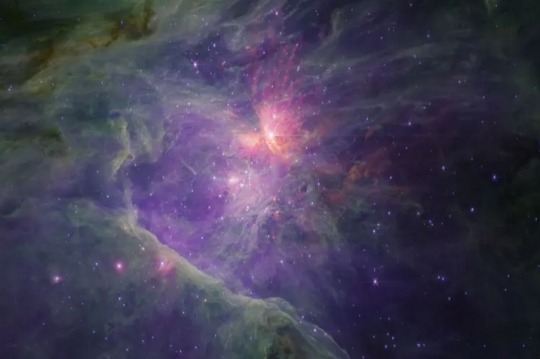
A pair of brilliant stellar nurseries located 1,600 light years from Earth, the Orion Nebula and Trapezium Cluster are home to a relative handful of very young but very bright stars.
Four of the stars are easy to see with a simple, amateur, four-inch telescope.
One of the four — the beast of the young litter — is especially visible, a full 20,000 times brighter than our sun.
Apart from their four main stars, the Orion Nebula and Trapezium cluster contain approximately 700 additional young stars at various stages of gestation.
NASA, ESA, CSA/Science leads and image processing: M. McCaughrean, S. Pearson, CC BY-SA 3.0 IGO

(L): It’s not easy being a Wolf-Rayet star, like this specimen imaged by the Webb telescope at a distance of 15,000 light years.
A rare species of stellar beast — NASA estimates there are only 220 of them in a Milky Way galaxy with at least 100 billion stars — the Wolf-Rayet burns hot and burns fast, with temperatures 20 to 40 times the surface of the sun.
All of that rapidly expended energy causes the star to lose its hydrogen envelope quickly and expose its helium core.
The result: a very early and very violent death.
A star like our sun burns for about 10 billion years. As for a Wolf-Rayet? Just a few hundred thousand before it dissolves into cosmic dust.
NASA, ESA, CSA, STScI, Webb ERO Production Team
(R): If the Wolf-Rayet star dies an ugly and violent death, the celebrated Ring Nebula, photographed by the Webb at a distance of 2,000 light years from Earth, has been expiring beautifully.
The glowing remains of a sun-like star, the nebula was discovered in 1779 by the French astronomer Antoine Darquier de Pellepoix.
As the nebula throws off its outer layers of ionized gas, it reveals its characteristic blue interior, composed of hydrogen and oxygen that have not yet been expelled off by the nebula’s stellar wind.
ESA/Webb, NASA, CSA, M. Barlow (University College London), N. Cox (ACRI-ST), R. Wesson (Cardiff University)

Dwarf galaxy NGC 6822 lives up to to its name — home to just 10 million stars, compared to the minimum of 100 billion in the Milky Way.
But what NGC 6822 lacks in numbers, it makes up in spectacle — which the keen eye of the Webb telescope has revealed.
Discovered in 1884 by American astronomer E.E Barnard, NGC 6822, is now known to have a prodigious dust tail measuring 200 light years across..
What's more, it's home to a dense flock of stars that glow 100,000 times brighter than our sun.
ESA/Webb, NASA & CSA, M. Meixnev

Spiral galaxies are often defined by uneven — and even ragged — arms.
But not galaxy M51, which lies 27 million light years from Earth and is defined by the tautness of its arms and the compactness of its structure.
M51 isn't alone in space. Nearby lies the companion galaxy NGC 5195.
The two galaxies are engaged in something of a gravitational tug of war — one that the NGC 5195 is winning.
NGC's constant gravitational pull is thought to account for both the tightly woven structure of M51's arms and for tidal forces that are thought lead to the creation of new stars in the arms.
ESA/Webb, NASA & CSA, A. Adamo (Stockholm University) and the FEAST JWST team
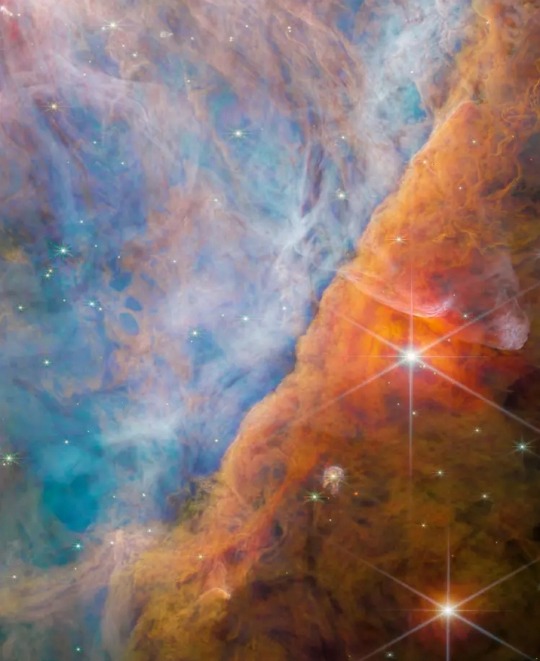
Just below Orion’s belt lies one of the most celebrated objects in the night sky: the Orion Nebula, a stellar nursery that is home to about 700 young stars.
This Webb image focuses not on the entirety of the nebula but on a structure in the lower left-hand quadrant known as the Orion Bar.
So named because of its diagonal, ridge-like appearance, the bar is shaped by the powerful radiation of the hot, young stars surrounding it.
ESA/Webb, NASA, CSA, M. Zamani (ESA/Webb), and the PDRs4All ERS Team

A baby by stellar standards, the IC 348 Star cluster is just five million years old and located about 1,000 light years from Earth.
Composed of an estimated 700 stars, IC 348 has a structure similar to wispy curtains, created by dust that reflects the light of the stars.
The conspicuous loop in the right hand side of the image is likely created by the gusting of solar winds blowing in the direction that, from Earth, would be west to east.
NASA, ESA, CSA, STScI, Kevin Luhman (PSU), Catarina Alves de Oliveira (ESA)
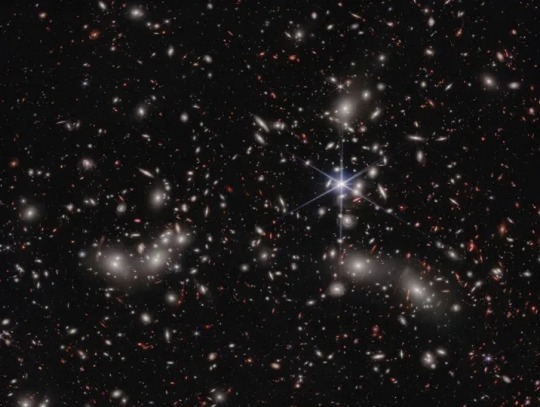
When it comes to galaxies, there's big and then there's huge and by any measure, Pandora's Cluster — more formally, known as Abell 2744 — qualifies as the latter.
Not just a galaxy, and not even a cluster of galaxies, Abell 2744 is a cluster of four clusters, which long ago collided with one another.
Located 3.5 billion light years from Earth, Pandora's Cluster measures a staggering 350 million years across.
The cluster's massive collective gravity allows astronomers to use it as a gravitational lens, bending and magnifying the light of foreground objects, making them easier to study.
NASA, ESA, CSA, I. Labbe (Swinburne University of Technology) and R. Bezanson (University of Pittsburgh). Image processing: Alyssa Pagan (STScI)

Webb was built principally to look at the oldest and most distant objects in the universe, some of 13.4 billion light years away.
But doesn't prevent the telescope from peering into its own back yard.
This image of Saturn and some of its 146 moons, rivals the images obtained by the Pioneer and Voyager probes.
NASA, ESA, CSA, STScI, Matt Tiscareno (SETI Institute), Matt Hedman (University of Idaho), Maryame El Moutamid (Cornell University), Mark Showalter (SETI Institute), Leigh Fletcher (University of Leicester), Heidi Hammel (AURA). Image processing: J. DePasquale (STScI)
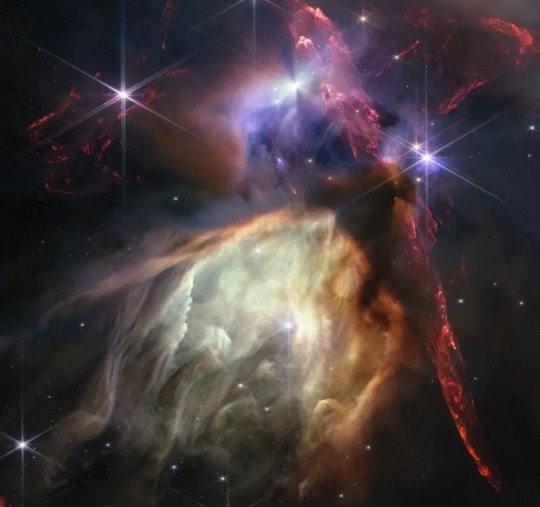
Infant stars are born all over the universe, but the closest stellar birthing suite to Earth is the Rho Ophiuchi cloud complex, located just 460 light years distant.
A turbulent — even violent — place, Rho Ophiuchi is defined by jets of gas roaring from young stars.
Most of the stars in this comparatively modest nursery are more or less the size of the sun.
But one, known as S1, is far bigger — so much so that it is self-immolating, carving a great cavity around itself with its stellar wind, the storm of charged particle's all stars emit, though few with the gale-force power of S1.
NASA, ESA, CSA, STScI, Klaus Pontoppidan (STScI)
#James Webb Telescope#James Webb Space Telescope#telescope#space#stars#galaxies#universe#cosmos#astronomy#space photography#photpgraphy#NASA#galactic clusters#milky way galaxy#Orion’s belt#Orion Nebula#Orion Bar#Pandora's Cluster#Saturn#Rho Ophiuchi cloud complex#Trapezium Cluster#Wolf-Rayet#Ring Nebula#Antoine Darquier de Pellepoix#E.E Barnard#spiral galaxy#nebula
112 notes
·
View notes
Photo

M74 346 !
Combining data from some of NASA’s most powerful instruments, four new composites highlight the enormity of the cosmos in unprecedented detail. Imagery from the Chandra Observatory and the James Webb and Hubble telescopes—plus infrared information from the Spitzer telescope’s final missions—mesh together to generate mesmerizing views of iconic nebulae and galaxies.
Composite X-ray: Chandra: NASA/CXC/SAO, XMM: ESA/XMM-Newton; IR: JWST: NASA/ESA/CSA/STScI, Spitzer: NASA/JPL/CalTech; Optical: Hubble: NASA/ESA/STScI, ESO; Image Processing: L. Frattare, J. Major, N. Wolk, and K. Arcand
#art#photography#space photography#M74 356#Xray#chandra#nasa#space#cosmos#cosmic#universe#james webb#chandra telescope#spitzer#nebulae#galaxy
218 notes
·
View notes
Text

Jets of material blasting from newborn stars, are captured in this James Webb Space Telescope close-up of the Serpens Nebula. The powerful protostellar outflows are bipolar, twin jets spewing in opposite directions. Their directions are perpendicular to accretion disks formed around the spinning, collapsing stellar infants.
Image Credit: NASA, ESA, CSA, STScI, Klaus Pontoppidan, Joel Green
769 notes
·
View notes
Photo

2024 October 22
M16: Pillars of Star Creation Image Credit: NASA, ESA, CSA, STScI; Processing: Diego Pisano
Explanation: These dark pillars may look destructive, but they are creating stars. This pillar-capturing picture of the Eagle Nebula combines visible light exposures taken with the Hubble Space Telescope with infrared images taken with the James Webb Space Telescope to highlight evaporating gaseous globules (EGGs) emerging from pillars of molecular hydrogen gas and dust. The giant pillars are light years in length and are so dense that interior gas contracts gravitationally to form stars. At each pillar's end, the intense radiation of bright young stars causes low density material to boil away, leaving stellar nurseries of dense EGGs exposed. The Eagle Nebula, associated with the open star cluster M16, lies about 7000 light years away.
∞ Source: apod.nasa.gov/apod/ap241022.html
132 notes
·
View notes
Photo

Wolf Rayet 124
Credits: NASA, ESA, CSA, STScI, Webb ERO Production Team
95 notes
·
View notes
Text

Pillars of Creation | Processed by Me.
Credit: James Webb Space Telescope, NASA/ESA/CSA, STScI, Me.
27 notes
·
View notes
Text
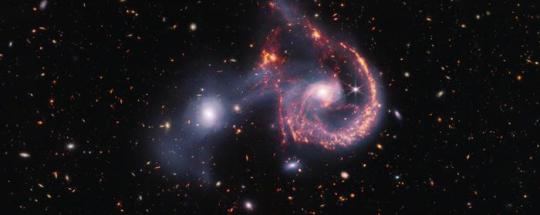

NASA’s Webb provides another look into galactic collisions
mile for the camera! An interaction between an elliptical galaxy and a spiral galaxy, collectively known as Arp 107, seems to have given the spiral a happier outlook thanks to the two bright “eyes” and the wide semicircular “smile.” The region has been observed before in infrared by NASA’s Spitzer Space Telescope in 2005, however NASA’s James Webb Space Telescope displays it in much higher resolution. This image is a composite, combining observations from Webb’s MIRI (Mid-Infrared Instrument) and NIRCam (Near-Infrared Camera).
NIRCam highlights the stars within both galaxies and reveals the connection between them: a transparent, white bridge of stars and gas pulled from both galaxies during their passage. MIRI data, represented in orange-red, shows star-forming regions and dust that is composed of soot-like organic molecules known as polycyclic aromatic hydrocarbons. MIRI also provides a snapshot of the bright nucleus of the large spiral, home to a supermassive black hole.
The spiral galaxy is classified as a Seyfert galaxy, one of the two largest groups of active galaxies, along with galaxies that host quasars. Seyfert galaxies aren’t as luminous and distant as quasars, making them a more convenient way to study similar phenomena in lower energy light, like infrared.
This galaxy pair is similar to the Cartwheel Galaxy, one of the first interacting galaxies that Webb observed. Arp 107 may have turned out very similar in appearance to the Cartwheel, but since the smaller elliptical galaxy likely had an off-center collision instead of a direct hit, the spiral galaxy got away with only its spiral arms being disturbed.
The collision isn’t as bad as it sounds. Although there was star formation occurring before, collisions between galaxies can compress gas, improving the conditions needed for more stars to form. On the other hand, as Webb reveals, collisions also disperse a lot of gas, potentially depriving new stars of the material they need to form.
Webb has captured these galaxies in the process of merging, which will take hundreds of millions of years. As the two galaxies rebuild after the chaos of their collision, Arp 107 may lose its smile, but it will inevitably turn into something just as interesting for future astronomers to study.
Arp 107 is located 465 million light-years from Earth in the constellation Leo Minor.
The James Webb Space Telescope is the world’s premier space science observatory. Webb is solving mysteries in our solar system, looking beyond to distant worlds around other stars, and probing the mysterious structures and origins of our universe and our place in it. Webb is an international program led by NASA with its partners, ESA (European Space Agency) and CSA (Canadian Space Agency).
TOP IMAGE: This composite image of Arp 107, created with data from the James Webb Space Telescope’s NIRCam (Near-Infrared Camera) and MIRI (Mid-Infrared Instrument), reveals a wealth of information about the star-formation and how these two galaxies collided hundreds of million years ago. Credit NASA, ESA, CSA, STScI
LOWER IMAGE: This image of Arp 107, shown by Webb’s MIRI (Mid-Infrared Instrument), reveals the supermassive black hole that lies in the center of the large spiral galaxy to the right. This black hole, which pulls much of the dust into lanes, also display’s Webb’s characteristic diffraction spikes, caused by the light that it emits interacting with the structure of the telescope itself. Credit NASA, ESA, CSA, STScI
23 notes
·
View notes